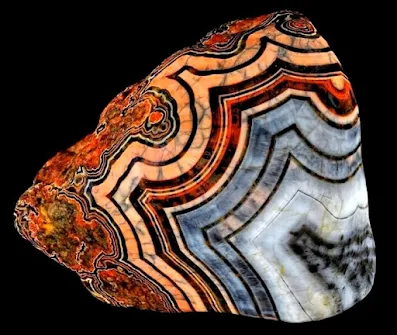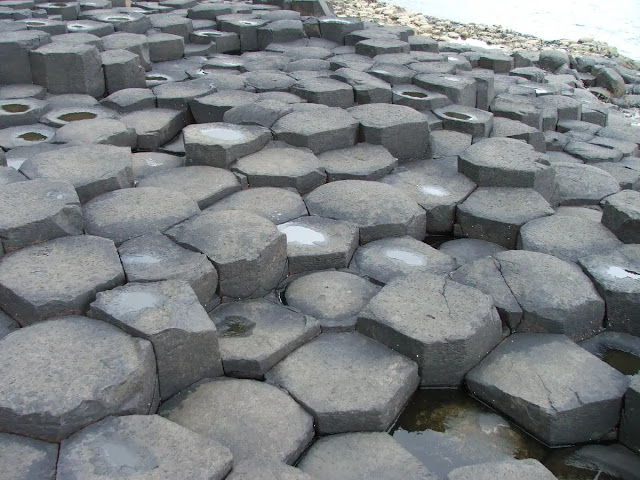How Do Agates Form
Agates are a type of chalcedony, which is a cryptocrystalline form of quartz. They are characterized by their banded patterns, which can be in a wide variety of colors, including red, orange, yellow, green, blue, purple, and pink, as well as black and white.
How is Agate Formed?
The formation of agates can take millions of years. The first step is for a crack or void to form in a rock. This can happen when the rock is heated or cooled unevenly, or when it is subjected to stress. Once a crack or void has formed, silica-rich groundwater can seep in. The silica in the water comes from the rock itself, or from other sources such as volcanic ash or hydrothermal vents.
As the silica-rich groundwater flows through the crack or void, it slowly deposits layers of silica on the walls. The rate at which the silica is deposited depends on a number of factors, including the temperature and acidity of the water, the amount of silica in the water, and the surface area of the walls of the crack or void.
The banding that is characteristic of agates is caused by the alternating deposition of layers of silica with different colors. The layers are deposited in thin bands because the silica is deposited in a very slow, continuous process.
The Process of Agate Formation
- A crack or cavity forms in a rock.
- Silica-rich groundwater seeps into the crack or cavity.
- The silica in the groundwater is deposited on the walls of the cavity, forming a thin layer of silica gel.
- The silica gel crystallizes, forming a layer of chalcedony.
- The process repeats itself, with new layers of chalcedony being deposited on top of the previous layers.
- Over time, the layers of chalcedony build up, forming an agate.
- The agate continues to grow over time as more silica is deposited.
- The different colors of agate are caused by impurities in the silica.
 |
| Rough Turkish Agate From North Ankara Photo: Menekse_Bilal08 |
What Cause Agates Color
Agate gets its color from the impurities that are present in the silica-rich water that forms it. The most common impurities that cause agate to have color are:
- Iron oxide: This is the most common impurity that causes agate to have color. It can cause agate to be red, brown, or yellow.
- Manganese oxide: This impurity can cause agate to be purple or pink.
- Chlorite: This impurity can cause agate to be green.
- Limonite: This impurity can cause agate to be yellow or brown.
- Hematite: This impurity can cause agate to be black.
Agate Name:
The agate name is derived from its occurrence at the Achates River in southwestern Sicily. A distinctly banded fibrous chalcedony. Originally reported from Dirillo river (Achates river), Acate, Ragusa Province, Sicily, Italy.
Where to Find Agate?
Most agates occur as nodules in volcanic rocks or ancient lavas, in former cavities produced by volatiles in the original molten mass, which were then filled, wholly or partially, by siliceous matter deposited in regular layers upon the walls. Agate has also been known to fill veins or cracks in volcanic or altered rock underlain by granitic intrusive masses. Such agates, when cut transversely, exhibit a succession of parallel lines, often of extreme tenuity, giving a banded appearance to the section. Such stones are known as banded agate, riband agate and striped agate.
Many agates are hollow, since deposition has not proceeded far enough to fill the cavity, and in such cases the last deposit commonly consists of drusy quartz, sometimes amethystine, having the apices of the crystals directed towards the free space so as to form a crystal-lined cavity or geode.
Agates can be found in a variety of places, but some of the best places to look include:
- Beaches: Agates are often found on beaches, especially in areas where there is a lot of volcanic activity. The waves and currents can help to expose agates that are buried in the sand.
- Rivers and streams: Agates can also be found in rivers and streams, especially in areas where there is a lot of sedimentary rock. The water can help to erode the rock and expose the agates.
- Dry riverbeds: Agates can also be found in dry riverbeds, especially in areas where there is a lot of volcanic activity. The water that once flowed through the riverbed can help to expose agates that are buried in the sand.
- Quarry tailings: Agates can also be found in quarry tailings, which are the piles of rock that are left over after a quarry has been mined. The quarry tailings can contain agates that were broken off from the bedrock during the mining process.
- Rock shops: Agates can also be purchased from rock shops. Rock shops often have a variety of agates for sale, including both rough and polished stones.
Tips for Finding Agate Stones
- Look for areas where there is a lot of erosion. This could be beaches, rivers, streams, or dry riverbeds.
- Look for areas where there are sedimentary or volcanic rocks. These rocks are more likely to contain agates.
- Look for rocks that have a banded or layered appearance. This is a sign that the rock may contain an agate.
- Use a rock hammer or a pick to break apart rocks that you think may contain an agate.
- Be patient. It may take some time to find agate stones.
When looking for agates, it is important to be aware of the different types of agates that can be found. Some of the most common types of agates here.
Note: Agate is not simply "banded chalcedony." There are other types of chalcedony that are banded that do not match the description above, banded flint, for example.
There are a number of varieties of chalcedony that are called "agate" that do not match the definition given above. Good examples are "feather agates" and "fire agates". These are listed as varieties of chalcedony, not as varieties of agate.
Agate characteristic types
1. Wall-lining Banding. The individual bands run perpendicular to the orientation and growth direction of the chalcedony fibers. Since the chalcedony fibers grow from the walls to the interior of a cavity, a concentric, onion-like pattern develops.
2. Horizontal Banding (also called Uruguay-type banding). This type of banding is less common, and usually accompanied by wall-lining banding. The banding consists of fine, irregularly spaced layers of small chalcedony spherulites and sometimes quartz crystals that precipitated in the cavity. Horizontal bands can serve as spirit levels to determine the original orientation of the specimen in the host rock. When the difference in translucency or color between the layers is pronounced, agates with horizontal banding can be used for cutting cameos and engravings.
If the nucleation points are distributed along the wall of a cavity, the typical wall-lining banding develops. Depending on the density of the initial nucleation points on the wall, the banding pattern will look more jagged like in so-called "fortification agates" (left column in Fig.) or will follow the outline of the cavity more uniformly (right column in Fig.). I have marked the different developmental stages of the spherulites with different colors to emphasize the geometry of the resulting banding.
 |
| Fairburn Agate, Credit: Tom "Captain Tenneal" Shearer |





%20(1).webp)




